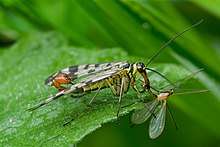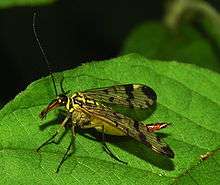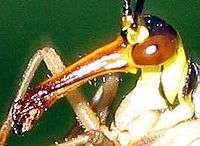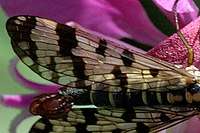Panorpa communis
Panorpa communis, the common scorpionfly,[1] is a species of scorpionfly.
| Panorpa communis | |
|---|---|
 | |
| P. communis male with prey | |
 | |
| P. communis female | |
| Scientific classification | |
| Kingdom: | Animalia |
| Phylum: | Arthropoda |
| Class: | Insecta |
| Order: | Mecoptera |
| Family: | Panorpidae |
| Genus: | Panorpa |
| Species: | P. communis |
| Binomial name | |
| Panorpa communis | |
Description
Panorpa communis can reach a body length of about 30 millimetres (1.2 in).[5] The common scorpionfly has a black and yellow body, with a reddish head and tail. The male has a pair of claspers at the end of its tail (for holding the female during mating),[5] giving it a scorpion-like appearance,[5] although it is not a stinger.
The adult insect has a wingspan of about 35 millimetres (1.4 in),[5] with wings that are mostly clear, but have many dark spots or patches. Its head, mounted with large eyes, is drawn into a prominent, downward pointing beak,[5] which opens at the tip of its head.
In the female, the eighth abdominal segment is the shortest, almost twice shorter than the seventh; the sixth is narrowed towards the back.[6] The larva resembles a caterpillar and grows up to 20 millimetres (0.79 in) long. It has three pairs of thoracic legs and eight pairs of prolegs.[7]
Biology and habits
The adult is seen between May and September.[5] They eat dead insects (although they sometimes eat live aphids), sometimes taking them from spider webs[5] and plant sap.[8]
Although fully winged, the adults rarely fly very far and spend much of their time crawling on vegetation in damp, shaded places near water and along hedgerows. Panorpa communis is a univoltine species.[5] Eggs are laid in soil annually and the larvae both scavenge and pupate there.[5]
Gallery
 Mating (female on the right)
Mating (female on the right) Head detail
Head detail Wing detail
Wing detail Male genitalia
Male genitalia
References
- in Kendall Bioresearch
- Fauna europaea
- Catalogue of life
- Range at GBIF
- UK Safari
- F. C. Fraser: Handbooks for the identification of British Insects. Vol. I. part 12 and 13. Mecoptera, Megaloptera, Neuroptera. Londyn: Royal Entomological Society of London, 1959, s. 8–10
- Strange animals
- "food" in uksafari.com
External links
- Peter Holden, Geoffrey Abbott RSPB Handbook of Garden Wildlife
- Bloomsbury Concise Garden Wildlife Guide
